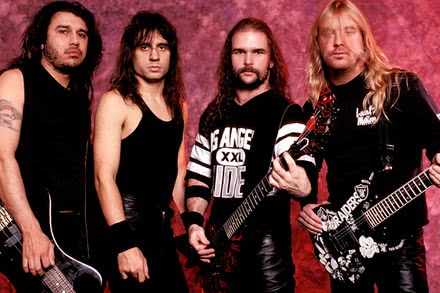In 1981 Tom Araya, Kerry King, Jef Hanneman and Dave Lombardo began playing Iron Maiden and Judas Priest covers at clubs and parties throughout California.
Aiming to replicate the wizardry of their pioneering heroes, they called themselves Slayer and meticulously worked at their craft, working odd jobs whilst playing local parties.
In 1983, after two years of playing anywhere and everywhere, Slayer was invited to open for the theatrical LA group Bitch.
The heavy community would never be the same again.
The group performed six covers and two originals that night; Aggressive Perfector & Chemical Warfare.
At that show was the young former music journalist-turned DIY record label owner Brian Slagel, who was looking for acts to add to his Metal Massacre mixtape, which featured little-known acts Metallica and Ratt.
Slayer quickly signed the band and work begun on the band’s debut LP Show No Mercy. The wheels were turning.
Love Music?
Get your daily dose of metal, rock, indie, pop, and everything else in between.
The cultural and musical impact imparted by Slayer goes without saying. Considered one of the ‘Four Horsemen’ of heavy metal (alongside fellow bay-area thrash acts Metallica, Megadeth & Anthrax) Slayer may not have invented speed metal, but they redefined how it was understood and pushed what we now understand as ‘thrash metal’ to a level of intensity never before seen, and never since matched.
Truthfully, things started conservatively (by the band’s standards) when it came to the sound. Show No Mercy certainly contained plenty of bite, and mixed with it’s low-budget but atmospheric production and screaming guitar solo’s it certainly held up as an impressive speed metal record. Slotting in alongside the sounds being made by the likes of Whiplash, Exodus & Forbidden, Slayer had arrived but they hadn’t presented anything necessarily new to the conversation.
Show No Mercy showed glimpses of what was to come

Hell Awaits began to change this, setting the grounds for the madness that was to follow. With longer, more progressive song structures the album showed that the band were willing to push the creative limits and not retreat into the ‘true metal’ pack.
With its hellish cover featuring images of satanic evil and malice, the band was beginning to embrace imagery that would extend to all manner of black, death, doom and melo-death bands in the decades to come. Branded “the most threatening, subversive band on the planet” by respected critic Geoff Barton, they made Iron Maiden’s evil mascot Eddie look like a cartoon in comparison with their occult themes.
“There was no real thinking behind it being evil. All I knew was that the songs were longer, and everybody else had albums with long songs” said Araya in an interview with The Quietus back in 2010.
While Hell Awaits might have been a case of following a gut instinct, their follow-up and literally genre-defining Reign in Blood in 1986 was pre-meditated to the last double bass kick of Raining Blood.
Released the same year as conceptual epics such as Metallica’s Master of Puppets, Megadeth’s Peace Sells…But Who’s Buying? & Anthrax’s Among The Living, Reign In Blood only clocks 29 minutes, fitting onto the one side of a tape and averaging a cozy 220 bpm’s.
Reign In Blood redefined extreme metal- check out why below

Produced by Rick Rubin, who at the time was primarily known for his work with hip-hop acts Run DMC & LL Cool J even locking in recording time with Rubin was a step in a new direction, let alone the fresh perspective and sheer balls-to-wall aggression that he would extract from the band.
“If we do a verse two or three times, we’re already bored with it. So we weren’t trying to make the songs shorter—that’s just what we were into”, said Hannerman of the recording. Upon completing the LP Rubin allegedly said to the band “do you realise how short this is?” The band’s response would be indicative of their entire career. “So what?”
Get your headbang on with Raining Blood live featuring fake blood falling from the ceiling
https://www.youtube.com/watch?v=5RXbhahXRuY
Reign In Blood took thrash metal as far as it could go. Taking the heaviness of bay area bands and combining it with the fast-paced double time of punk/hardcore acts GBH & Verbal Abuse, among others, it took the genre to an intensity that, if matched, would almost become a joke.
Tracks like Piece By Piece, Altar of Sacrifice and Criminally Insane condensed the epics heard off other band’s LP’s into 1-2 minute thrashing bursts, combining both impeccable musical composition chops with technical intensity.
Nothing done since has ever offered anything new in terms of speed and intensity, and the album is cited by many as a landmark moment in their own musical journey.
Oderus Urungus of Gwar said of the album that “It’s the one I would always play for my friends when I was getting into Slayer. They would get this glazed look in their eyes and worship the speakers while doing the devil-horn thing.”
More broadly speaking John Conserdine, head of extreme metal magazine, Terrorizer, notes that without Slayer’s influence, “extreme metal as we know it wouldn’t exist.” Kam Lee of both Massacre and Death says that “there wouldn’t be death metal or black metal or even extreme metal (the likes of what it is today) if not for Slayer,” while Alex Skolnick of Testament notes that “Before Slayer, metal never had such razor-sharp articulation.” Reign In Blood was the definition of this articulation, and is known to have influenced extreme metal monolith’s Napalm Death, Obituary, Cannibal Corpse, Morbid Angel…the list will forever extend, due to that album.
One thing that metal-heads will always somewhat unfairly be accused of is their narrow-minded take on change within the genre. An arbitrary loyalty to “true thrash” never existed when it came to Slayer. Follow-up albums South Of Heaven & Seasons Of The Abyss expanded their thrash sound to include more grooves, slower marches and greater depth of songwriting. Both records are now regarded as classics, featuring live staples Mandatory Suicide & War Ensemble on their track lists. Fan’s would also be wrong to shun the heaviness of follow up LP’s Divine Intervention & the down-tuned 90’s assault captured on Diabolus In Musica.
Diabolus In Musica saw Slayer tune down the guitars, but not lose their appetite for violent sounds

The band’s final unholy trinity of LP’s; Christ Illusion, World Painted Blood & 2016’s Repentless certainly didn’t have the same groundswell that their early 80’s material generated. However, were they meant to? The band stuck to their traditional guns across those records, despite inner turmoil.
The departure of drumming pioneer Dave Lombardo and death of founding member Jeff Hanneman rocked both band and fanbase to their core, but the band continued to dominate the stage around the globe, up until the announcement this year that they would be embarking on one final world tour.
The bands that featured on the first leg of that tour alone; Anthrax, Behemoth, Testament & Lamb of God, all can rightfully credit Slayer for paving the way for the sounds that they would build their own subsequent career’s off.
Testament, who feature on Slayer’s final world tour, continue to push the style that Slayer brought screaming out of the underground

March 2019 will be the final time that Australian fans get to take in the power of Slayer, with the group gifting us four final thrash-fests before resting their necks for good.
Sticking to their guns, a refusal to conform & the courage to get back out there in the direst of circumstances, all done with unrelenting fury and intensity; those factors are the reason why there will never be another Slayer, and you’ll never have another chance to risk your life in the pit after their visit this year. Dates below.
Slayer Final Australian Tour, 2019
Thursday, March 7th- Riverstage Brisbane
TICKETS
Saturday, March 9th- Download Festival, Paramatta Park, Sydney
TICKETS
Monday, March 11th- Download Festival, Flemington Racecourse Melbourne
TICKETS
Wednesday, March 13th- Adelaide Entertainment Centre, Adelaide
TICKETS


































